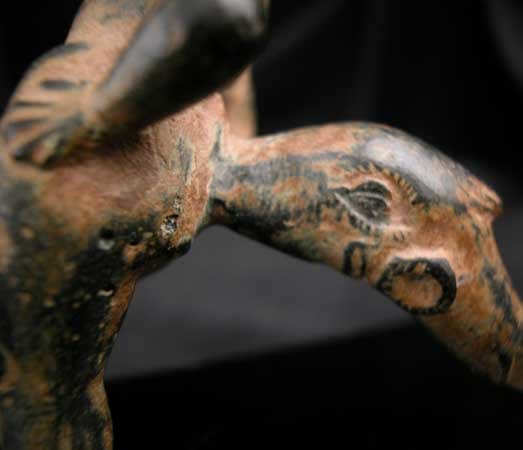Bronze Fragment Depicting a Youth and a Dolphin, 200 BCE - 200 CE
Bronze
1.5 x 3 x 2.5
Z.0139
Further images
Bacchus, while most commonly being associated with the peaceful and gentle pleasures that go hand in hand with the consumption of fine wine, suffered a traumatic childhood and turbulent youth...
Bacchus, while most commonly being associated with the peaceful and gentle pleasures that go hand in hand with the consumption of fine wine, suffered a traumatic childhood and turbulent youth in mythology. As a young God disguised as a mortal, he was taken hostage by a pirate crew mistaking him for a wealthy prince. Bacchus, in retribution, overgrew their ship with grape-vine, but as it plunged into the sea he mercifully turned the doomed sailors into dolphins. We see here the androgynous and pretty form of Bacchus, nosed along through the sea by some unfortunate sailor. This elegant, though unusual sculpture probably formed part of the carrying handle of a metal chest. Another human figure would have provided the second vertical. Perhaps the other person was Atocles, the helmsman, who upon recognizing Bacchus, urged the other pirates to yield and was rewarded with his life. A pair of dolphins would have created the horizontal cross bar.
What mystery could have been held within the chest this handle was attached to? Perhaps it sat aboard some ship- the vivid artistry of the handles serving as a reminder to any potential prying eyes or vacant hands as to how the Gods treat the piratical or just plain avaricious. The graceful movement, the intricate detail, and striking activity of this handle render it a masterpiece in its own right. Pieces such as this provide us with a dazzling fragment of a tantalizing mystery- and give us a handle on a world that was infinitely more beautiful- more full of myth and story- than our own.
This elegant--though unusual--sculpture probably formed part of the carrying handle of a metal chest. Another nude youth would have provided the second vertical, while a pair of dolphins would have created the horizontal cross bar. The artistic quality of the sculpture, especially in the sensitive rendering of the human figure, is very high, comparable to works on a much larger scale. There is no question that what we have with this splendid fragment is a tantalizing clue to a vanished masterpiece.
What mystery could have been held within the chest this handle was attached to? Perhaps it sat aboard some ship- the vivid artistry of the handles serving as a reminder to any potential prying eyes or vacant hands as to how the Gods treat the piratical or just plain avaricious. The graceful movement, the intricate detail, and striking activity of this handle render it a masterpiece in its own right. Pieces such as this provide us with a dazzling fragment of a tantalizing mystery- and give us a handle on a world that was infinitely more beautiful- more full of myth and story- than our own.
This elegant--though unusual--sculpture probably formed part of the carrying handle of a metal chest. Another nude youth would have provided the second vertical, while a pair of dolphins would have created the horizontal cross bar. The artistic quality of the sculpture, especially in the sensitive rendering of the human figure, is very high, comparable to works on a much larger scale. There is no question that what we have with this splendid fragment is a tantalizing clue to a vanished masterpiece.
Literature
V4









